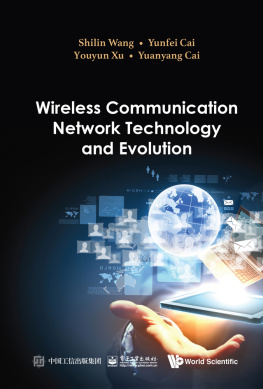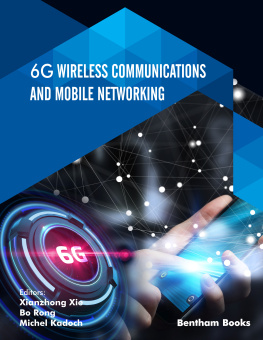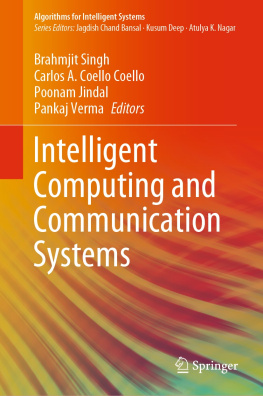R. Kanthavel - Artificial Intelligent Techniques for Wireless Communication and Networking
Here you can read online R. Kanthavel - Artificial Intelligent Techniques for Wireless Communication and Networking full text of the book (entire story) in english for free. Download pdf and epub, get meaning, cover and reviews about this ebook. year: 2022, genre: Home and family. Description of the work, (preface) as well as reviews are available. Best literature library LitArk.com created for fans of good reading and offers a wide selection of genres:
Romance novel
Science fiction
Adventure
Detective
Science
History
Home and family
Prose
Art
Politics
Computer
Non-fiction
Religion
Business
Children
Humor
Choose a favorite category and find really read worthwhile books. Enjoy immersion in the world of imagination, feel the emotions of the characters or learn something new for yourself, make an fascinating discovery.
- Book:Artificial Intelligent Techniques for Wireless Communication and Networking
- Author:
- Genre:
- Year:2022
- Rating:5 / 5
- Favourites:Add to favourites
- Your mark:
- 100
- 1
- 2
- 3
- 4
- 5
Artificial Intelligent Techniques for Wireless Communication and Networking: summary, description and annotation
We offer to read an annotation, description, summary or preface (depends on what the author of the book "Artificial Intelligent Techniques for Wireless Communication and Networking" wrote himself). If you haven't found the necessary information about the book — write in the comments, we will try to find it.
R. Kanthavel: author's other books
Who wrote Artificial Intelligent Techniques for Wireless Communication and Networking? Find out the surname, the name of the author of the book and a list of all author's works by series.
Artificial Intelligent Techniques for Wireless Communication and Networking — read online for free the complete book (whole text) full work
Below is the text of the book, divided by pages. System saving the place of the last page read, allows you to conveniently read the book "Artificial Intelligent Techniques for Wireless Communication and Networking" online for free, without having to search again every time where you left off. Put a bookmark, and you can go to the page where you finished reading at any time.
Font size:
Interval:
Bookmark:

Scrivener Publishing
100 Cummings Center, Suite 541J
Beverly, MA 01915-6106
Artificial Intelligence and So Computing for Industrial Transformation
Series Editor: Dr. S. Balamurugan ()
Scope: Artificial Intelligence and So Computing Techniques play an impeccable role in industrial transformation. The topics to be covered in this book series include Artificial Intelligence, Machine Learning, Deep Learning, Neural Networks, Fuzzy Logic, Genetic Algorithms, Particle Swarm Optimization, Evolutionary Algorithms, Nature Inspired Algorithms, Simulated Annealing, Metaheuristics, Cuckoo Search, Firey Optimization, Bio-inspired Algorithms, Ant Colony Optimization, Heuristic Search Techniques, Reinforcement Learning, Inductive Learning, Statistical Learning, Supervised and Unsupervised Learning, Association Learning and Clustering, Reasoning, Support Vector Machine, Dierential Evolution Algorithms, Expert Systems, Neuro Fuzzy Hybrid Systems, Genetic Neuro Hybrid Systems, Genetic Fuzzy Hybrid Systems and other Hybridized So Computing Techniques and their applications for Industrial Transformation. The book series is aimed to provide comprehensive handbooks and reference books for the benefit of scientists, research scholars, students and industry professional working towards next generation industrial transformation.
Publishers at Scrivener
Martin Scrivener ()
Phillip Carmical ()
Edited by
R. Kanthavel
K. Ananthajothi
S. Balamurugan
R. Karthik Ganesh

This edition first published 2022 by John Wiley & Sons, Inc., 111 River Street, Hoboken, NJ 07030, USA and Scrivener Publishing LLC, 100 Cummings Center, Suite 541J, Beverly, MA 01915, USA
2022 Scrivener Publishing LLC
For more information about Scrivener publications please visit www.scrivenerpublishing.com.
All rights reserved. No part of this publication may be reproduced, stored in a retrieval system, or transmitted, in any form or by any means, electronic, mechanical, photocopying, recording, or otherwise, except as permitted by law. Advice on how to obtain permission to reuse material from this title is available at http://www.wiley.com/go/permissions.
Wiley Global Headquarters
111 River Street, Hoboken, NJ 07030, USA
For details of our global editorial offices, customer services, and more information about Wiley products visit us at www.wiley.com.
Limit of Liability/Disclaimer of Warranty
While the publisher and authors have used their best efforts in preparing this work, they make no representations or warranties with respect to the accuracy or completeness of the contents of this work and specifically disclaim all warranties, including without limitation any implied warranties of merchantability or fitness for a particular purpose. No warranty may be created or extended by sales representatives, written sales materials, or promotional statements for this work. The fact that an organization, website, or product is referred to in this work as a citation and/or potential source of further information does not mean that the publisher and authors endorse the information or services the organization, website, or product may provide or recommendations it may make. This work is sold with the understanding that the publisher is not engaged in rendering professional services. The advice and strategies contained herein may not be suitable for your situation. You should consult with a specialist where appropriate. Neither the publisher nor authors shall be liable for any loss of profit or any other commercial damages, including but not limited to special, incidental, consequential, or other damages. Further, readers should be aware that websites listed in this work may have changed or disappeared between when this work was written and when it is read.
Library of Congress Cataloging-in-Publication Data
ISBN 978-1-119-82127-4
Cover image: Pixabay.Com
Cover design by Russell Richardson
Set in size of 11pt and Minion Pro by Manila Typesetting Company, Makati, Philippines
Printed in the USA
10 9 8 7 6 5 4 3 2 1
In the current digital era, artificial intelligence (AI) resembling human intelligence is enabling superior inventions for the advancement of the world. Broadening the scientific scope of AI has made it possible to change fundamentals and modulate everlasting facts in the wireless communication and networking domains. This breakthrough in AI miraculously preserves the inspired vision of communication technology.
Wireless communication and networking based on AI concepts and techniques are explored in this book, specifically focusing on the current research in the field by highlighting empirical results along with theoretical concepts. The possibility of applying AI mechanisms towards security aspects in the communication domain is also elaborated. Moreover, the application side of integrated technologies are also explored to enhance AI Revolution innovations, insights, intelligent predictions, cost optimization, inventory management, identification processes, classification mechanisms, cooperative spectrum sensing techniques, ad-hoc network architecture, and protocol and simulation-based environments.
This book allows both practitioners and researchers to share their opinions and recent research on the convergence of these technologies with those in academia and industry. The contributors have presented their technical evaluation and comparative analysis of existing technologies; and theoretical explanations and experimental case studies related to real-time scenarios are also included. Furthermore, this book will connect IT professionals, researchers, and academicians working on 5G communication and networking technologies.
The book is organized into 20 chapters that address AI principles and techniques used in wireless communication and networking. It outlines the benefits, functions, and future role of AI in wireless communication and networking. In addition, AI applications are addressed from a variety of aspects, including basic principles and prominent methodologies that offer researchers relevant instructions to follow in their research. The editing team and expert reviewers in various disciplines have thoroughly reviewed the information included.
- In , Comprehensive and Self-Contained Introduction to Deep Reinforcement Learning, P. Anbalagan, S. Saravanan and R. Saminathan present a brief guide to the deep reinforcement learning process and its detailed applications and research directions in order to enhance the basics of reinforcement mechanisms.
- In , Impact of AI in 5G Wireless Technologies and Communication Systems, A. Sivasundari and K. Ananthajothi present an in-depth overview of the implementation of AI to improve 5G wireless communication systems, discuss the role and difficulties faced, and highlight suggestions for future studies on integrating advanced AI into 5G wireless communications.
- In , Artificial Intelligence Revolution in Logistics and Supply Chain Management, P.J. Satish Kumar, Ratna Kamala Petla, Elangovan K and P.G. Kuppusamy give a brief description of recent developments and some relevant impacts concerning logistics and supply chain related to AI.
- In , An Empirical Study of Crop Yield Prediction Using Reinforcement Learning, M. P. Vaishnnave and R. Manivannan use reinforcement learning (RL) data technologies and high-performance computing to create new possibilities to activate, calculate, and recognize the agricultural crop forecast.
Font size:
Interval:
Bookmark:
Similar books «Artificial Intelligent Techniques for Wireless Communication and Networking»
Look at similar books to Artificial Intelligent Techniques for Wireless Communication and Networking. We have selected literature similar in name and meaning in the hope of providing readers with more options to find new, interesting, not yet read works.
Discussion, reviews of the book Artificial Intelligent Techniques for Wireless Communication and Networking and just readers' own opinions. Leave your comments, write what you think about the work, its meaning or the main characters. Specify what exactly you liked and what you didn't like, and why you think so.








